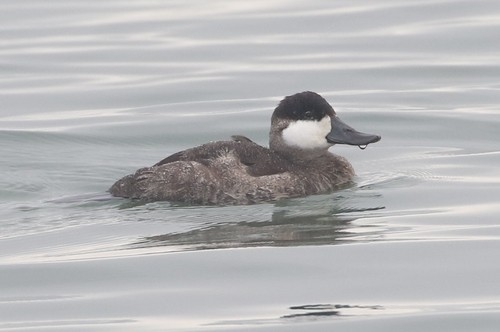Ruddy Duck
A species of Stiff-tailed ducks, Also known as Spiketail Scientific name : Oxyura jamaicensis Genus : Stiff-tailed ducks
Ruddy Duck, A species of Stiff-tailed ducks
Also known as:
Spiketail
Botanical name: Oxyura jamaicensis
Genus: Stiff-tailed ducks
Content
Description People often ask General Info
 Photo By silversea_starsong , used under CC-BY-NC-4.0 /Cropped and compressed from original
Photo By silversea_starsong , used under CC-BY-NC-4.0 /Cropped and compressed from original Description
These are small, compact ducks with stout, scoop-shaped bills, and long, stiff tails they often hold cocked upward. They have slightly peaked heads and fairly short, thick necks. Male ruddy ducks have blackish caps that contrast with bright white cheeks. In summer, they have rich chestnut bodies with bright blue bills. In winter, they are dull gray-brown above and paler below with dull gray bills. Females and first-year males are brownish, somewhat like winter males but with a blurry stripe across the pale cheek patch. In flight, ruddy ducks show solidly dark tops of the wings. 
Size
36-41 cm (14-16 in)
Colors
Brown
Black
Red
White
Cyan
Life Expectancy
13 years
Nest Placement
Ground
Clutch Size
3 - 13 eggs
Incubation Period
1 - 2 broods
Number of Broods
20 - 26 days
Nestling Period
1 day
Feeding Habits
Ruddy Duck mainly consume aquatic invertebrates like insects, crustaceans, and zooplankton, often foraging by diving and straining mud through bill plates. Their diet includes midge larvae, amphipods, and snails, supplemented with plant material such as seeds and roots, especially during migration and winter.
Habitat
Ruddy Duck's habitat encompasses wetlands such as marshes, lakes, ponds, and reservoirs in both freshwater and brackish conditions. They thrive from lowland to highland freshwater systems within temperate to subtropical climates. During winter, ruddy Duck frequent saltwater bays. Their preferred environments are abundant with wetland vegetation, crucial for breeding and shelter.
Nest Behavior
Ruddy Duck's nesting process commences with the female selecting the site. Egg-laying is typically a clutch of eggs, with parental care predominantly handled by the females, who incubate the eggs and rear the young, often solo.
Nest Characteristics
Ruddy Duck's nest is placed 2–10 inches above water amid cattails, bulrushes, or grasses, camouflaged by vegetation. It's constructed from dead or green plant materials, forming a platform that develops into a bowl-like shape with a 4–12 inch wide and 0.5–5 inch deep inner cup, often featuring an overhead canopy of vegetation.
Dite type
Aquatic invertebrate eater
People often ask
General Info
Feeding Habits
Bird food type
Sounds
Call
Recording location: United States
Behavior
Ruddy Duck primarily dwell on water, engaging in swift flight with limited aerial agility. They are prone to swimming or diving over flying as an escape strategy from various predators. Notably aggressive, ruddy Duck exhibit distinct competitiveness among themselves and other species, particularly during mating season. Unique courtship involves males, with vertical tails, emitting a bubbly display by striking their inflated necks, capped with a distinctive burp-like sound. Additionally, males perform a remarkable water-running ritual, creating a popping noise with their feet. Pair bonds are seasonally monogamous, with some instances of polygamy, and they produce remarkably large eggs. Offspring are precocial but receive scant maternal attention and no paternal care, facing threats from multiple predators.
Species Status
Not globally threatened.
Scientific Classification
Phylum
Chordates Class
Birds Order
Waterfowl Family
Geese Genus
Stiff-tailed ducks Species
Ruddy Duck